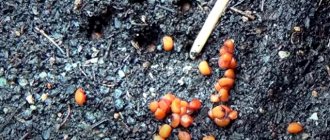Abutilon is a perennial evergreen plant from the Malvaceae family .
In its natural environment it is found in the tropics of South America, Asia, and Africa. China is considered the homeland. It grows very quickly, sometimes reaching 2 m. Some species in nature grow up to 4 m. With proper care, abutilon pleases with long-lasting flowering - from April to late autumn. Flowers can be of different colors: red, peach, salmon, purple, pink. They look like magic lanterns and are formed on long stalks at the end of the shoot, while the growth of the shoot does not stop. The plant is often called the indoor maple because its wedge-shaped green leaves with jagged edges resemble the foliage of a tree.
| In one season, the plant doubles or triples in growth. |
| Blooms in autumn, summer and spring. |
| Abutilone is easy to grow. |
| Perennial. |
Useful properties of abutilone
Abutilone is a plant that gives joy. A sad mood transforms into a powerful charge of vigor; helps to reveal talents, creates an atmosphere of love and harmony. Contemplation of a flowering tree relieves stress. The type Abutilon Theophrastus is useful. Its juice is used to treat furunculosis and heal wounds. Strong ropes are made from abutilon branches. For this he is called a ropeman.
Important points
When growing Abutilone, it should be noted that the plant:
- does not tolerate direct sunlight;
- afraid of drafts;
- perfect for organizing flower beds;
- in the summer you will feel better in the open ground;
- Suitable for greenhouses and large rooms.
Abutilone is a fast-growing large plant that requires free placement, so it is recommended to grow it in spacious rooms. This abundantly and long-blooming tree with delicate foliage will decorate any interior.
Caring for abutilone at home (briefly)
Abutilone at home can bloom for almost a year. Despite its spectacular appearance, indoor maple does not require special care, but it must be cared for competently.
| Temperature | In winter - at least 12° C, the rest of the time - within 23 - 25° C. |
| Air humidity | High humidity is desirable; in drier air, frequent spraying is recommended. |
| Lighting | Well lit places. |
| Watering | During flowering - abundant, in winter - moderate. |
| Priming | Buy a ready-made substrate (acidity level 6 pH); You can prepare it yourself by taking equal parts humus, leaf soil and half a share of sand. |
| Feeding and fertilizer | In the phase of active growth and flowering - once every 14 days with mineral fertilizers or organic matter. |
| Transfer | Young bushes - every year, adults - once every 3 years (in the spring, before the period of intensive growth). |
| Reproduction | Cuttings and seeds. |
There are features of growing abutilone . In spring its growth accelerates. Some shoots grow randomly, thickening and worsening the appearance, taking away the strength of the plant. Therefore, at the end of winter, abutilon is cut off, leaving half the height, removing weak shoots. When it begins to grow powerfully, it is tied to a support.
Application, benefit, harm
Abutilon is used for decorative purposes (for example, ampere types look good against the background of a stretch ceiling). It also has technical uses after processing. From it they produce:
- rope burlap;
- ropes;
- ropes of high ktex and high-quality weaving.
That is why it has another name - cord. It does not have harmful properties, but for some people it becomes an allergen. There is a sign that the cord brings trouble to the home, but this is just superstition.
Caring for abutilone at home. Details
Homemade Abutilon is a shrub of tropical origin. The beauty and duration of flowering and the longevity of the plant depend on care. At home, it is difficult to create conditions that coincide with those to which the indoor maple tree is genetically predisposed, but it is necessary to get as close to them as possible.
Planting abutilone
Planting abutilon plays an important role in the formation of a beautiful, strong tree. When deciding to grow abutilon at home, choose a place for it in advance. The best option is a draft-protected and well-lit part of the room: the plant needs light at any time of the year. In summer you can put it on the balcony or take it outside. Fresh air and rays of sun will help the tree quickly get stronger and grow.
Bloom
Abutilon flowering is a colorful and long-lasting phenomenon. Starts at the end of April and ends in late autumn. During flowering, bright original lantern flowers are formed on the branches. They consist of 5 petals collected at the base and can be of different colors. The diameter of the flower reaches 7 cm.
Temperature
In order for abutilon to grow healthy and strong, good care at home is needed. It is required to maintain a suitable temperature regime : hypothermia is as dangerous as overheating. In the warm season, the room where abutilone grows should be + 22 - 27°C, in winter and autumn - no less than + 15°C. If it feels uncomfortable, it will show dissatisfaction: at high temperatures it will begin to dry out, at low temperatures it will shed leaves.
Sudden changes in temperature should be avoided.
Spraying
Abutilone is not very demanding on air humidity. But during the heating season and on hot days, when the air becomes dry, periodic spraying of the leaves is required. To avoid burning them, this is done out of the light.
Lighting
To form lush green foliage, abutilon needs good lighting. It loves bright places, but bright sunlight causes leaf burn. Therefore, it is recommended to choose diffuse lighting . The tree is placed next to windows facing south. In autumn and winter, when the length of daylight hours is reduced, additional lighting is installed.
Watering
Abutilon loves moisture, but both lack of moisture and waterlogging of the soil are dangerous for it. A lack of moisture leads to shedding of leaves and slower growth, and an excess leads to falling buds, drying out of the foliage, and root rot.
In summer, abutilon is watered frequently (up to 3 times a week). To keep the soil moist for a long time, it is loosened and mulched with coconut substrate and crushed bark. After flowering, moderate watering is needed - once every 10 days .
Water with settled water at room temperature.
Pot size
If the tree is grown from seeds, take a small container for sowing. Abutilone develops quickly. As it grows, increase the size of the pot. The need to change the container will be indicated by the appearance of roots from the drainage holes, shredding of flowers and slower growth.
In order not to bring the shrub to a critical state, the diameter of the pot is gradually increased until it becomes optimal for abutilon - 13 - 15 cm. The diameter of each new container should be 2 cm larger than the previous one. Some types of abutilone live more than 8 years; long-lived plants are grown in tubs.
Primer for Abutilone
Loose, humus-rich soil for abutilon is the key to growing a strong, beautiful tree . The soil is quickly depleted because the indoor maple uses up nutrients instantly. To help the plant replenish their supply, the soil is updated twice a year, taking into account the acidity of the soil.
The development of the tree occurs faster in neutral or slightly acidic soil (pH approximately 6), which can be prepared at home by adding vermicompost, vermiculite, and sand to the peat mixture.
Feeding and fertilizer
Abutilone slows down its development from November to March, when its dormant period is observed. At this time, feeding is prohibited: excessive stimulation will deplete the plant. In the flowering and growth phase, on the contrary, organic feeding and fertilization with minerals are important. They are carried out once every 2 weeks after watering.
When abutilone forms buds, phosphorus and potassium are needed. With an excess of nitrogen, the tree grows quickly, but does not bloom. Use liquid fertilizers for flowering plants. They contain useful substances in the right proportions and are easily digestible.
Transfer
The indoor maple tree needs a transplant. It is carried out after noticing the signs that Abutilon gives:
- slow growth;
- small flowers;
- roots protrude from drainage holes;
- the buds fall;
- light spots appear on the leaves due to lack of nutrition;
- The diameter of the crown visually exceeds the diameter of the pot.
When replanting (transferring) abutilon from one pot to another, renew the container if necessary. Refresh the soil, remove dense accumulations of roots and damaged roots. The cut areas are sprinkled with crushed coal. Young bushes are replanted once a year, adults - after 3 years. It is better to do this in cloudy weather so that the plant can more easily tolerate transplantation.
Is it suitable for shaping bonsai?
Abutilone is rarely used for bonsai formation because it is slow in growth and often gets sick. The formation of a tree can be carried out by observing the following rules:
- prune when the plant has 5 pairs of leaves, shortening it by 2–4 leaves;
- cuttings should be left, removing large leaf blades, which will fade over time and be replaced by smaller leaves;
- in mid-summer, the growth buds should be plucked out, which will cause a slowdown in growth and the formation of shorter shoots suitable for bonsai;
- pruning is carried out in summer and early autumn. At this time, wounds on the plant heal faster, and the recovery period takes a shorter period of time.
Abutilon is an unpretentious indoor plant that gives solar energy to others. With proper care and attention, a flower can become a worthy decoration for a living space.
Reproduction of Abutilone
A new tree can be obtained using seeds or cuttings.
Propagation of abutilone by cuttings
Usually, at the age of 5 years, the trunk becomes woody, and abutilon becomes less attractive. Propagation by cuttings is a good option for renewing a tree. It is better to do this from spring to late summer. Cuttings 15 cm long are cut from strong branches, clearing the lower leaves and flowers. Place, slightly tilting, in moist soil. Water, mulch, cover with film. To prevent condensation from accumulating, several holes are made. The seedlings are kept warm, at a temperature of 22 - 25°. The film is regularly removed for ventilation and watering. After a month, the cuttings take root and are transplanted into a pot.
Growing abutilone from seeds
Propagation by seeds is not always convenient: they quickly lose their germination capacity. It is better to sow last year's seeds. In the spring, large seeds are selected and treated in a solution of potassium permanganate. Furrows are made in the soil and the seeds are placed at a distance of 20 mm from each other, deepening them by 5 mm. The container with seedlings is covered with polyethylene. Make holes to allow the seedlings to “breathe”. Keep at a temperature of 20 - 23°C. The film is removed to moisten and ventilate the soil. After 3 weeks, the first shoots appear. When 2 leaves grow, the seedlings are planted in pots and placed in a bright place away from drafts. After 4 - 6 months, the abutilon will bloom.
Variegated species are propagated only by cuttings in order to preserve the biological characteristics of the parent plant.
Preparing for landing
Before considering the rules of transplantation, it is necessary to choose the right container for the ropeway and determine what kind of land is needed. When choosing a pot or other container for planting a flower, you must remember that the flower is replanted annually.
And since the flower grows quite quickly and the roots also develop rapidly, the container where the flower will grow must be deep enough. For young cuttings, choose a pot or flowerpot whose diameter varies between 7–10 cm.
Find out how to properly plant indoor flowers in a pot.
The rope plant prefers non-acidic, airy soil.
You can prepare the desired mixture at home using:
- 1 part humus;
- 2 parts of turf land;
- 1 part leaf soil;
- 0.5 parts sand.
You can also use ready-made soil, for example, “Palma”, which is sold in any flower shop.
Diseases and pests of Abutilon
The plant is unpretentious, but improper care can cause problems:
- Abutilone sheds its leaves due to improper watering (stagnation of water or lack of moisture), sudden changes in lighting or temperature, draft.
- The tips of the abutilone leaves dry out and curl - the air in the room is very dry. It is necessary to spray the leaves (without touching the flowers); put away from the batteries, place an open container of water next to the pot.
- The yellow color of abutilon foliage means dry air, hot room, lack of nitrogen. Carry out spraying, ventilation, fertilizing.
- Pale color of foliage - little light. The plant is moved to a brighter place.
With very dry air and excessive watering, abutilon is attacked by pests: aphids, scale insects, mealybugs, spider mites, whiteflies, thrips. To combat them, insecticides are used and the conditions of the plant are changed.
Types of homemade abutilone with name and photo
More than 100 types of abutilone are known. Some of them, adapted to home life, are grown at home. They are small in size, bloom for a long time and do not require special maintenance conditions.
Abutilon Megapotamicum, or Abutilon Amazonian
The shrub grows up to 1.5 m. The stems are thin and drooping. The length of the elongated oval leaves with jagged edges reaches 8 cm. Single flowers hang on long stalks. The red corolla has a tubular-ribbed shape.
The petals, which have a red spot at the base, are yellow. With proper care it blooms all year round. In England it is called a “weeping Chinese lantern.”
Abutilon Vitifolium
A tall branched shrub, grows up to 2 m. Bright green leaves with jagged edges reach 20 cm, have from 3 to 5 lobes. The inflorescences are painted blue or lilac, with dark veins on the petals. The flowers are arranged in groups. Long shoots are covered with fluff. Blooms from late April.
Abutilon Sellowianum
Grows up to 2 m. Slightly branched straight shoots are pubescent. The pointed, elongated, three-lobed leaves have a smooth texture and serrated edges. The flowers are soft purple with pink veins. The flowering period falls on July - December.
Abutilon spotted, or Abutilon painted (Abutilon Pictum / Striatum)
A shrub with flexible short shoots and multi-lobed green leaves on long petioles. They have a heart-shaped appearance, white spots and jagged edges. Golden flowers with dark pink veins are shaped like a bell. Formed in the axils of leaves. Flowering occurs at the very end of summer.
Abutilon hybrid (Abutilon Gybridum)
Abutilone is obtained artificially by crossing different plant species. An evergreen tree 1.5 m high. Petals can be painted in different colors: pink, white, orange, red, yellow, burgundy. Veins are always visible on them - dark or light. The shape of the flowers resembles bells. The leaves are covered with delicate hair, have 3–5 lobes and long petioles.
Abutilon is a beautiful plant that can refresh and decorate the interior. Brings peace and joy to the home. It is responsive to basic care, and with good care it is ready to bloom all year long.
Description
The genus includes: perennial evergreen and deciduous varieties; bushes, trees. They have woody or herbaceous shoots. Reach a height of 4 m in their natural environment.
- On the long stem there are harsh fibers or soft felt. Usually the shoots branch heavily.
- The leaves are dissected into several lobes. They are similar to maple trees: dark greenish or gray in tone with a blue tint and pointed ends. Therefore, abutilion has a popular name - indoor maple.
- In some representatives, the greens have a striped or speckled appearance. The length of the leaves does not exceed ten centimeters. Not all of them are maple-shaped; variegated varieties have heart-shaped greens.
When flowering, bell-shaped buds are formed. Their diameter reaches eleven centimeters. There are types of terry abutilon with large corolla petals. The flower has different colors (depending on the subspecies). More often the flowers are single, formed in the axils of greenery.











